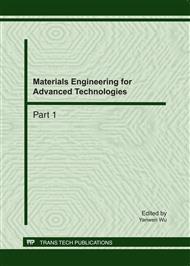[1]
A. Nishikata, Y. Ichihara, T. Tsuru, An application of electrochemical impedance spectroscopy to atmospheric corrosion study, Corros. Sci. 37 (1995): 897-911.
DOI: 10.1016/0010-938x(95)00002-2
Google Scholar
[2]
A. Nishikata, Y. Ichihara, T. Tsuru, Electrochemical impedance spectroscopy of metals covered with a thin electrolyte layer, Electrochim. Acta, 41(1996): 1057-1062.
DOI: 10.1016/0013-4686(95)00438-6
Google Scholar
[3]
G.S. Frankel, M. Stratmann, M. Rohwerder, A. Michalik, B. Maier, J. Dora, M. Wicinski, Potential control under thin aqueous layers using a Kelvin Probe, Corros. Sci. 49(2007): 2021-(2036).
DOI: 10.1016/j.corsci.2006.10.017
Google Scholar
[4]
Y. Tsutsumi, A. Nishikata, T. Tsuru, Pitting corrosion mechanism of Type 304 stainless steel under a droplet of chloride solutions, Corros. Sci. 49 (2007) 1394-1407.
DOI: 10.1016/j.corsci.2006.08.016
Google Scholar
[5]
S. Hastuty, A. Nishikata, T. Tsuru, Pitting corrosion of Type 430 stainless steel under chloride solution droplet, Corros. Sci. 52 (2010) 2035-(2043).
DOI: 10.1016/j.corsci.2010.02.031
Google Scholar
[6]
Y.J. Tan, Wire beam electrode: a new tool for studying localised corrosion and other heterogeneous electrochemical processes, Corros. Sci. 41(1999)229-247.
DOI: 10.1016/s0010-938x(98)00120-6
Google Scholar
[7]
Q. Zhong, Wire-beam electrode: a new tool for investigating electrochemical inhomogeneity of oil coatings, Prog. Org. Coat. 30(1997) 279-285.
DOI: 10.1016/s0300-9440(97)00004-0
Google Scholar
[8]
Q. Zhong, Study of corrosion behaviour of mild steel and copper in thin film salt solution using the wire beam electrod, Corros. Sci. 44(2002) 909-916.
DOI: 10.1016/s0010-938x(01)00098-1
Google Scholar
[9]
W. Wang, X. Zhang, J. Wang, The influence of local glucose oxidase activity on the potential/current distribution on stainless steel: a study by the wire beam electrode method, Electrochim. Acta 54(2009) 5598-5604.
DOI: 10.1016/j.electacta.2009.04.064
Google Scholar
[10]
X. Zhang, W. Wang, J. Wang, A novel device for the wire beam electrode method and its application in the ennoblement study, Corros. Sci. 51(2009) 1475-1479.
DOI: 10.1016/j.corsci.2009.03.002
Google Scholar
[11]
T. Liu, Y.J. Tan, B.Z.M. Lin, N.N. Aung, Novel corrosion experiments using the wire beam electrode. (IV) Studying localised anodic dissolution of aluminium, Corros. Sci. 48 (2006) 67–78.
DOI: 10.1016/j.corsci.2004.11.022
Google Scholar


